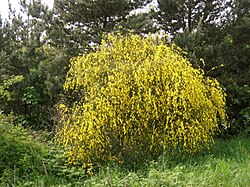
A shrub or bush is a horticultural rather than strictly botanical category of woody plant, distinguished from a tree by its multiple stems and lower height, usually less than 6 m tall. A large number of plants can be either shrubs or trees, depending on the growing conditions they experience. Small, low shrubs such as lavender, periwinkle and thyme are often termed subshrubs.
A natural plant community dominated by shrubs is called a shrubland. The word bush can also refer to a type of plant community, as in the Australian bush. This is often characterised by scrubby, open woodland and is a generic term for Eucalyptus dominated woodland in particular.
An area of cultivated shrubs in a park or garden is known as a shrubbery. When clipped as topiary, shrubs generally have dense foliage and many small leafy branches growing close together. Many shrubs respond well to renewal pruning, in which hard cutting back to a 'stool' results in long new stems known as "canes". Other shrubs respond better to selective pruning to reveal their structure and character.
Shrubs in common garden practice are generally broad-leaved plants, though some smaller conifers such as Mountain Pine and Common Juniper are also shrubby in structure. Shrubs can be either deciduous or evergreen.
List of shrubs (bushes)
Those marked * can also develop into tree form.
External links
- Selecting Shrubs for Your Home (University of Illinois Extension)